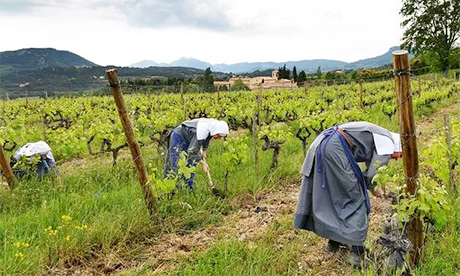In the famous Good Samaritan Parable of the Gospel of St. Luke, the first gesture of the Samaritan traveller, at the sight of the man left half-dead by robbers on his way to Jericho, was to pour oil and wine over his wounds.
Such a metaphor, designed to evoke the concrete manifestation of God’s love in the life of human beings wounded by sin, has had a lasting cultural impact on Christian societies that since then have always associated these two culinary elements with sanctuaries of divine tenderness and mercy.
It is with this desire to offer the people of God a glimpse of divine goodness that the Benedictine monks and nuns of Le Barroux, in the Provence-Alpes-Côte d’Azur region of southeastern France, have followed in the footsteps of their predecessors, who, since St. Benedict of Nursia, has been at the leading edge of the production of wine in the West.
They have resumed the wine-growing activity of their lands were, almost seven centuries earlier, Pope Clement V planted the first papal vineyard of France.
In 1309, this pope who is known for having moved the papacy from Rome to Avignon and settled his vacation resort in the Benedictine monastery of the Groseau in Malaucène, a small village adjacent to Le Barroux, located at the foot of Mont Ventoux.
The straw wine produced by this vineyard was particularly appreciated by his successor, Pope John XXII, who continued to serve it to its most distinguished guests.
But it was not until the 20th century, after the First World War, that the winemakers of the canton of Malaucène started to enhance this terroir by striving to develop high-quality products, with a desire to honour the glorious papal heritage of their land. Their long quest for excellence was rewarded in 1973 when they obtained the status of “AOC Ventoux” (Protected Designation of Origin).
It was at that period of time that monks returned to this region when Dom Gérard Calvetestablished the Abbey of Sainte-Madeleine du Barroux, located on Malaucène’s borders. Their wine-growing activity, however, did not start until the arrival of a community of nuns at the adjacent Abbey of Our Lady of the Annunciation, in 1986.
Saving an endangered terroir
This monastic presence, whose farming activity focuses mainly on the winery and the production of olive oil, turned out to be a true blessing for local families of winegrowers, at a time when it has become increasingly difficult for them to earn a decent living.
“There has been a lot of land abandonment over the past decade; small winemakers could no longer live from their work because the Ventoux designation was undervalued and winemakers were losing money,” Gabriel Teissier, director of development at Via Caritatis, told the Register. “Indeed, mountain agriculture, made of many small and nested plots, cannot be mechanized, and they were forced to do a very hard and uneconomical precision work on their vineyards.”
The monks of the Barroux Abbey, whose winery consists of an archipelago of small plots shared with other winemakers, rapidly understood that the precariousness of the situation could also represent an opportunity.
Indeed, their environmental factors, called terroir(located at a height of 1,000 to 1,150 feet, between Mont Ventoux and the Dentelles de Montmirail range), benefiting at the same time from the Mediterranean climate of the south of France, the mountain freshness and from different soil types that complement each other, has all the necessary characteristics to make grand cru wines.
This is how, in 2015, the monks offered to join forces with their winemaker neighbours and make their terroir gain its letters of nobility in the wine industry. Continue reading
